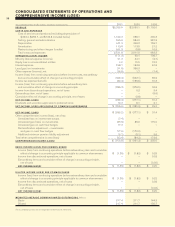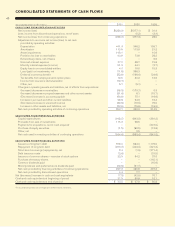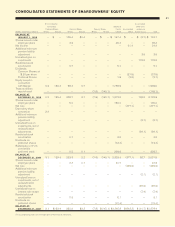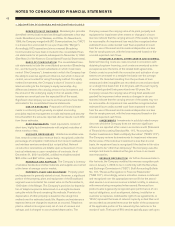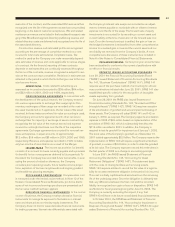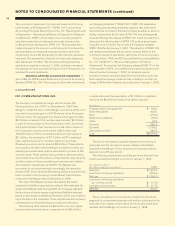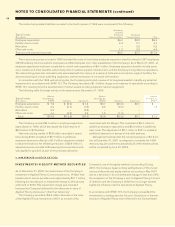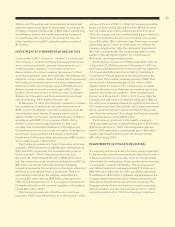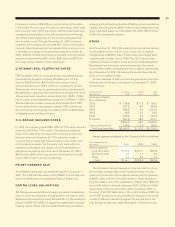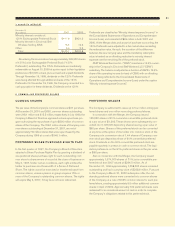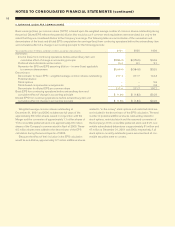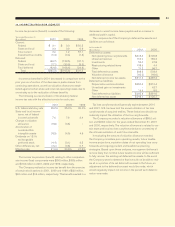Cincinnati Bell 2001 Annual Report Download - page 49
Download and view the complete annual report
Please find page 49 of the 2001 Cincinnati Bell annual report below. You can navigate through the pages in the report by either clicking on the pages listed below, or by using the keyword search tool below to find specific information within the annual report.
47
Statements of Operations and Comprehensive Income (Loss)
under the caption “Loss (gain) on investments.” Accordingly, the
Company recognized pretax losses of $5.9 million, representing
the diffference between the market value and the Company’s
recorded basis of the investment. This investment was com-
pletely liquidated during 2001, generating sales proceeds of
$1.8 million.
INVESTMENTS IN MARKETABLE SECURITIES
On November 2, 2001, Anthem Inc. (“Anthem”), a mutual insur-
ance company in which the Company held various medical and
vision insurance policies for coverage of its employees, con-
verted to a public company in a transaction known as a
demutualization. As a mutual company, the owners of Anthem
were the policyholders. Upon demutualization, the Company was
entitled to receive a certain number of shares, which represented
the Company’s ownership interest in the newly created stock
enterprise. In 2001, the Company received 459,223 shares of
Anthem common stock and recorded a gain of $19.7 million
based on the fair market value of the stock in the Consolidated
Statements of Operations and Comprehensive Income (Loss)
under the heading “Other expense (income), net.”
At December 31, 2001, the Company’s investment in Anthem
was classified as a “trading” security under the provisions of
SFAS 115 and classified as a short-term investment on the bal-
ance sheet because it was the Company’s intent to sell all
shares of Anthem on the open market during January of 2002. In
accordance with SFAS 115, an increase of $3.0 million in
Anthem’s market value through December 31, 2001 was
included in the Consolidated Statements of Operations and
Comprehensive Income (Loss) under the caption “Loss (gain) on
investments.” In January 2002, the Company sold its entire
investment in Anthem generating cash proceeds of $23.4 million
and an additional gain of $0.6 million.
The Company’s investment in Corvis Corporation, which was
acquired in 2000, totaled zero and $190 million at December 31,
2001 and 2000, respectively. The unrealized holding gain on
Corvis included in “Other Comprehensive Income” as of
December 31, 2000 totaled $132 million ($86 million, net of
tax). The market value of the investment declined during 2001 by
$69 million, net of taxes, before the Company completely
hedged its exposure to this investment as described in Note 6 of
the Notes to Consolidated Financial Statements. Therefore,
upon delivery of the shares, the Company reclassified the
remaining $17 million after tax ($26 million pretax) gain from
“Other Comprehensive Income” to “Loss (gain) on investments”.
Proceeds received from the complete liquidation of the holdings
totaled $82 million in 2001.
The Company’s investment in ZeroPlus.com, which was
acquired in 1999, totaled $0.6 million as of December 31, 2000
and zero at the end of 2001. In 1999, the Company recorded a
pretax unrealized holding gain of $13 million ($9 million net of
tax). The market value of this investment declined throughout
2000. The change in the net unrealized holding gain, reflected in
“Other Comprehensive Income” over this period, was a pretax
loss of $23 million ($15 million net of tax). There were no unreal-
ized holding gains or losses as of December 31, 2000 as the
Company recognized an “other than temporary” impairment of
$10 million during the year. The Company liquidated its entire
position in this security during 2001 for a realized loss of
$0.6 million, receiving minimal proceeds.
The Company’s investment in PSINet totaled $15 million as
of December 31, 2000 and zero as of December 31, 2001 as
the Company liquidated its entire investment through settlement
of a forward sale further described in Note 6 of the Notes to
Consolidated Financial Statements and sale of shares in the
open market. The Company received proceeds of $28 million
and recorded a realized pretax gain of $17 million in 2001
related to these transactions. The cost basis was calculated
based on the related cost. There was no unrealized gain or loss
related to the investment included in “Other Comprehensive
Income” as of December 31, 2000 or 2001. During 1999, the
Company recorded a pretax unrealized holding gain of $85 mil-
lion, which was completely reversed during 2000 as the value of
the investment declined. During 2000, the Company determined
that its investment had been impaired and that the impairment
was “other than temporary”. Accordingly, the Company recorded
a realized pretax loss totaling $342 million.
The Company’s investment in PurchasePro, acquired in
1999, generated a pretax unrealized holding gain of $115 million
($76 million net of tax) in 1999. The entire position was liqui-
dated in 2000 generating a realized pretax gain of $49 million,
based on the related cost. Proceeds from the sale totaled
$50 million during 2000.
INVESTMENTS IN OTHER SECURITIES
The Company periodically enters into certain equity investments
for the promotion of business and strategic objectives. A portion
of these investments is in securities, which do not have readily
determinable fair market values. These investments are recorded
at cost based on specific identification. The carrying value of
cost method investments was approximately $16 million and
$38 million as of December 31, 2001 and 2000, respectively.
The difference of $22 million is related to realized losses as the
Company determined that the value of these investments had
declined and that the decline was other than temporary. The
Company reviews these investments on a regular basis using
external valuations and cash flow forecasts as factors in deter-
mining the existence of an “other than temporary” impairment.



